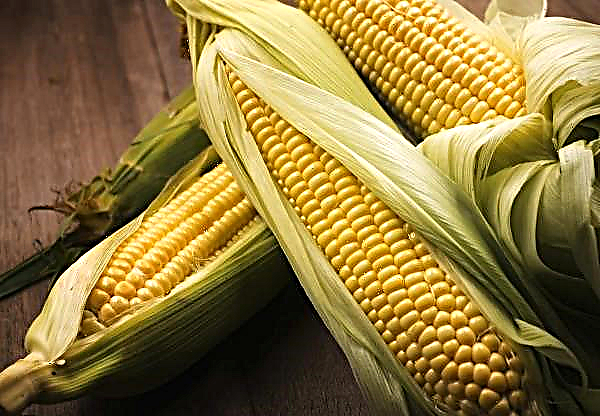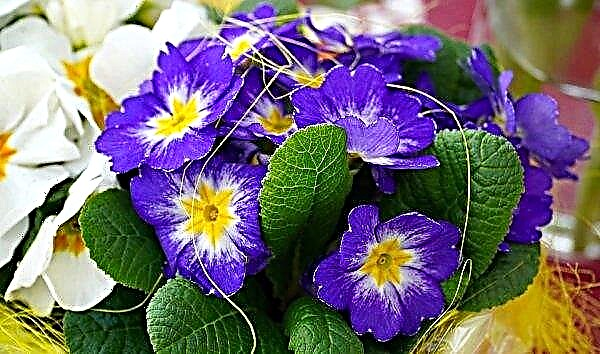In the gardens of Russia you can often see beautiful, brightly colored flowers with delicate petals fluttering in the wind. Florists love this perennial plant for its unpretentiousness and decorativeness. This culture is bearded iris, to which the article is devoted, it will describe the most famous varieties and give photos with names.
Beautiful varieties of bearded irises
This culture got such an unusual name due to the fact that on the inner side of the petals there are strips of short, densely arranged hairs. They can be either a contrasting color with respect to the flower, or plain. Plant height, color and time of occurrence of the buds also vary depending on the variety.
Edith wolford
The plant blooms in late spring, on the border with the beginning of summer. Depending on the weather and climate of cultivation, the opening of buds can last from the first decade of May to mid-June, but rarely less than 4 weeks. First, a bunch of green leaves, shaped like a sword, comes out of the ground. Further, vertical fruit stems are formed with very large bicolor flowers, having a diameter of 10 to 15 cm. They have very thin and delicate petals, the edges of which end with wavy frills.
 The Edith Wolford variety is extremely photophilous, so it is impossible to achieve full development in the shade or partial shade. In this case, irises will be low, small or ugly in shape.
The Edith Wolford variety is extremely photophilous, so it is impossible to achieve full development in the shade or partial shade. In this case, irises will be low, small or ugly in shape.
In the middle of the flower, the petals are painted in a light yellow tone, the lower ones have a blue-violet color. This variety has been awarded many awards at exhibitions in various countries of the world. During the growing season, the iris requires garter, as its height reaches a meter. The plant is great for cutting. The bouquet will delight the hosts with freshness up to 10 days, provided that the water in the vase changes daily.
Edith Wolford loves good fertile soils, therefore for full flowering, the variety must be fertilized twice a year: in early spring and late summer. Underground roots should be dug up and separated every 3-4 years; August is the most suitable time for this work.
Important! Rhizomes of iris can be poisonous, so they can not be eaten. It is also advisable to monitor small children so that they do not pull the leaves of this plant into their mouths, as this can be hazardous to health.
Poem of ecstasy
This bicolor variety has huge flowers, the diameter of which reaches 30 cm. The middle of the bud is painted in an ash-pink tone, and the bottom is in lavender. The petals are very large, their lower part is highly corrugated, which creates the effect of lightness and airiness.
The height of the bush Poem of Ecstasy reaches 80–90 cm, erect leaves, elongated-lanceolate, gray-green. The plant forms up to 7 leaves. Iris of this variety requires obligatory garter, as the fruit arrow does not hold huge, heavy flowers poorly. From 5 to 7 fruit buds are formed on each peduncle.
 The buds bloom sequentially, as soon as one flower withers, the next one immediately blossoms, so this period is stretched for 3-4 weeks
The buds bloom sequentially, as soon as one flower withers, the next one immediately blossoms, so this period is stretched for 3-4 weeks
Poem of Ecstasy loves loose, permeable soils. His better placed in the sun, but the variety can also develop normally in partial shade. It requires regular fertilizer, can grow in one place up to 10 years, subject to free space, allowing rhizome to grow.
Grade does not tolerate heavy rains, as thin petals get wet, and the flowers wilt, losing their decorative effect. Suitable for cutting, looks very nice in formal bouquets.
Important! The gardener needs to manually remove dried or withered iris flowers, as they not only reduce the overall decorativeness of the plant, but also slow down the development of the following buds.
World premier
The variety is very decorative, the diameter of each flower reaches 13-15 cm, the last buds on the fruit arrow may have a smaller circle. Petals are collected in a magnificent rounded ball, very thin, delicate, highly corrugated at the edges. The middle is painted in blue and white, the bottom is black and blue, the edges are bright, with a light fringing of the same tone. There is a white beard on the inside.
The leaves are collected in bunches of 5-7 pieces, have a xiphoid shape and a green, slightly bluish color. Bushes are high, from 80 to 90 cm, require mandatory garter to wooden stakes or support of another kind. Each peduncle forms from 2 to 7 flowers.
World Premier blooms closer to mid-summer depending on the region of cultivation, usually in June - July. This period takes from 2 to 4 weeks, in the heat flowering ends faster, so regular watering is recommended. It is recommended to irises to water only under the root, in no case should be watered by the method of sprinkling, as this is detrimental to the flowers.
The variety loves its location in the sun, but without loss for decorativeness tolerates a slight shadow. It prefers neutral or slightly acidic soil, therefore, along with mineral fertilizers, it is recommended to add a little lime to the substrate of the flowerbed. Due to the intensive flowering, the plant requires top dressing several times a season. Strongly does not tolerate strong winds, therefore, for their landing, it is better to choose places protected by the wall of the house or a fence.
Important! A signal to the gardener to start work on the separation of perennial irises can be that a significant part of the underground rhizomes is shown above the soil. This means that the flowers have grown excessively, and if you do not take measures, in the next seasons of vegetation will be oppressed.
Immortality
The variety belongs to the German group of irises, the first flowers appear in June. They are large and medium in size and have white rounded petals. Immortality is characterized by a strong aroma, spicy and sweet. The smell becomes especially intense in cool weather or after rain. Flowering lasts 14–25 days, depending on the air temperature, everything happens faster in the heat.
The plant grows many long lanceolate leaves, from 7 to 9 pieces. They have a green color and are located in a bunch, fastening at the base of the peduncle. The height of the fruit arrow reaches 65–70 cm, making Immortality considered a low grade. If they are planted in a dense group, they can grow without a garter, supporting each other.
 Immortality has good frost resistance, can tolerate a cold period without additional insulation of underground rhizomes. It is advisable to plant these perennials in the sun. Since the rhizome grows rapidly, the gardener periodically needs to carry out its separation and the seating of new divisions
Immortality has good frost resistance, can tolerate a cold period without additional insulation of underground rhizomes. It is advisable to plant these perennials in the sun. Since the rhizome grows rapidly, the gardener periodically needs to carry out its separation and the seating of new divisions
For lush flowering iris soil should be well fertilized. Given that the plant actively absorbs nutrients from the earth, it is required to feed it several times during the warm season. Immortality also has high requirements for soil moisture, so in the dry period a moderate weekly watering under the root is required.
Silverado
Silverado is a tall species of bearded irises. The size of the flowers is very large, 10-12 cm in diameter. They have a round lush shape, visually consisting of two tiers. The color of the rounded, thin and corrugated petals is monophonic, silver-blue with a delicate lilac hue, very light. Flowers are arranged on tall and dense fruit arrows in a checkerboard pattern, starting to blossom from the lowest, one after the other. At the same time, 3-4 buds can bloom, making the variety look great in bouquets.
Silverado fragrance is very weak, almost imperceptible. The flowering period can last up to 3 weeks, the first buds open already in late May. Peduncles require additional support, under the weight of blossoming flowers, the fruit arrow falls to the ground, and the plant loses its beauty. This variety was awarded the Dykes Medal in 1994, which is the highest award for this culture.
Likes to settle on bright, windproof places. It does not tolerate prolonged stagnation of moisture in the soil, as this causes the development of fungal diseases of the root system and decay. For this reason, it is not recommended to plant irises in clay dense soils and lowlands.
It requires a systematic division of the root (every 2-3 years), otherwise the flowering will be sparse and short. The division is best done in warm weather, in the fall until the last September decade. It has good winter hardiness, can be planted in composition with other perennial street plants.
Caroline gold
Caroline Gold - a variety of tall plain irises with a bush height of 70 to 80 cm. The fruit stems are strong, branched, with oppositely arranged flower buds. The flower is solid, large. Part of the petals, painted in bright yellow color, is located upward, part - hangs down, their outer side is bordered by a beard from often located hairs. Each edge ends with a wide corrugated border of the same color. Golden buds of this variety of irises are reflected in the name of the variety - Caroline Gold.
The leaves are elongated, have the shape of a sword, erect, green with a wax coating, collected in bunches. The plant blooms in June or July, depending on the region where it is grown. At air temperatures below + 25 ° C, the variety blooms longer and more colorful. In a single landing, it requires fixing on a support; in a group arrangement, the garter can be neglected.

The most beautiful flowering can be achieved by placing Caroline Gold in lighted areas. It is important that the flower beds with irises of this variety are protected from the wind.to avoid lodging peduncles. The plant also tolerates minor shading. Particular attention should be paid to gardeners to drain the flowerbed to prevent stagnation of water in the root layer.
Slew O’Gold
The variety belongs to plants with medium flowering periods. Usually this period falls in mid-summer, late June or July. The flower is large, consists of a two-story lush bunch of petals, most of which are located upward, and the lower layer hangs to the ground. Rounded and wide, they have a delicate corrugated structure, they are easily damaged by touch of the fingers. The coloration of the lower and upper tiers has a monotonous saturated yellow color. Beard hairs are bright orange.
Slew O’Gold is a tall plant, its stem stably reaches a height of 90–94 cm, so the plant needs additional support, especially during flowering or in the rainy season. Wet weather negatively affects the beauty of the iris, as wet petals sag under the weight of water. Drying, the flowers do not return to their original state, so it is advisable for the gardener to remove them from the stem manually.
The bluish-green leaves of a classic elongated-lanceolate shape, dense, leathery, fleshy, are directed upwards. With good nutrition and loose soil, Slew O’Gold can throw several peduncles, therefore it requires additional mineral nutrition several times a season. It grows in one place from 7 to 10 years, preferably before planting the rhizomes to add organic matter rich in nitrogen (humus, compost) to the soil. Requires division of the roots no more than once every 5-6 years.

In cool weather, flowering lasts up to 5 weeks, in heat - no more than 15 days. These irises are recommended to be grown in an individual garter., or horizontally install a plastic net with wide cells at a height of 40–45 cm in spring above a flower bed in spring. The variety is suitable for commercial cultivation, as it retains freshness for a long time after cutting.
Blueberry bliss
Very tall plant the bush often reaches a mark of 107-110 cm. The lush monophonic flower is large (10–13 cm), has semicircular petals of saturated blue color, a corrugated edge and a beard of the same, but slightly darker color. Blueberry Bliss belongs to the group of early-average flowering period, usually occurring in different decades of June, depending on the average daily temperature at this time.
Did you know? The name of the iris came to Russia from the Latin language. People often use more familiar names, such as saber or cockerels.
The variety does not tolerate planting in the shade, and also reacts poorly to excessive thickening.arising from years of growing in one place. In this case, the Blueberry Bliss may upset the gardener with a practical lack of flowers. The trouble can only be helped by seating and dividing the underground of the iris. Dense, erect lanceolate leaves remain upright until the fall, decorating a faded flower bed with greens.
Due to the excessive height of the peduncles, Blueberry Bliss is grown only with additional support, which is offset by a large number of flower buds on the fruit arrow. The plant looks good in festive flower arrangements, especially in combination with asparagus or other cultures that have a "lace" structure of leaves.
 For commercial purposes, it is recommended to grow under shelter (in greenhouses or under summer canopies), as it completely loses decorativeness under the influence of strong winds and rain
For commercial purposes, it is recommended to grow under shelter (in greenhouses or under summer canopies), as it completely loses decorativeness under the influence of strong winds and rain
Cascade springs
The plant has lush flowers with lower petals spread wide to the sides, which creates additional volume and the illusion of enormity. Their diameter can reach 12-15 cm, the color of the petals is monophonic, but has a difference in the degree of concentration of tone: the middle collected by the magnificent ball is the color of a stormy sky, and the lower edge is almost white, with a slightly noticeable lavender hue. The furrow hairs are pale blue.
The height of the bush is up to 1 m, the leaves are vertically arranged, strong, gray-green. With good care, Cascade Springs throws from 1 to 3 fruit shooters, which makes the plant bloom very spectacular and bright. This period begins in the first two months of summer and lasts from 3 to 5 weeks.
 Garter is recommended in the early stages of vegetation. The variety is frost-resistant, but provided that some of the roots are not on the soil surface. When waterlogging the soil has a tendency to develop root rot
Garter is recommended in the early stages of vegetation. The variety is frost-resistant, but provided that some of the roots are not on the soil surface. When waterlogging the soil has a tendency to develop root rot
Medici prince
Prince Medici refers to late-blooming varieties of bearded irises. The burgundy color of the petals has a gradation in degree of saturation: the lush floral middle looks paler in relation to the lower levels bordering it. The focus is dark yellow, which creates a beautiful contrast with the petals.
Did you know? One of the wonders of the world, the Indian palace Taj Mahal, has wall murals that depict irises. An amazing monument of architecture built in the XVII century.
It differs from other varieties by a large number of flowers, 12 to 14 pieces can form on one stem. Also, one of the important features of Medici Prince is its resistance to moisture, the plant does not lose its decorativeness in the rain. The stem is quite dense and stable, but in order to avoid bending or lodging on the ground, gardeners are advised to garter to a wooden peg or trellis. The leaves are thick, fibrous, maintain a vertical position until the plant withers completely in the fall. The color of the stem and leaves is green, with a bluish wax coating.
Plant height varies from 90 to 100 cm, depending on the location, illumination and soil saturation with nutrients. Flowering occurs late - in the middle or in the second half of summer. This variety blooms later than all varieties of this culture.
Magical glow
The flower of this variety has corrugated petals with a bright orange tone. It is large, consists of two tiers, the upper of which looks like a heap of delicate fabric, and the lower - like a folded frill of a skirt. The hairs of the barb are identical in color.
The bush rarely exceeds a height of 70–80 cm, consists of a bunch of leaves (7-8 pieces) and one or more arrows, they have the same gray-green color. The fruit arrow forms from 2 to 8 buds, which open in succession.
Did you know? There is a Japanese holiday for boys, which is celebrated by the inhabitants of the country on May 5, it is called "Cebu no sekku." The symbol of this day are the irises, which the Japanese decorate at home.
The period when the buds open begins in late June or early July. In the first year after planting, the plant may bloom sparingly or not throw out buds at all. This is true for sick or weakened irises.
Magical Glow is prone to quickly build up the underground part, so needs timely separation of rhizomes into several separate plants. In a thickened state, forms small flowers.

Cherry blossom song
These irises belong to the American selection and have awards received in various thematic exhibitions. A very decorative flower has a bicolor color: a pale pink, almost creamy middle, and the bottom of a light lilac tone with a pale border. Petals are large, corrugated, beard hairs have an apricot hue.
The height of the iris bush is 80–91 cm. Green leathery leaves are arranged in a vertical bundle and are attached to the bottom of the plant. On one iris there can be from 1 to 3 fruit shoots, it depends on the age of the rhizome and the degree of nutrition of the soil in which it grows.
The flowering periods have no clear boundaries, but the first blossoming buds can be seen on the plant closer to mid-summer, in the first half of July. The duration of this period varies from 2 to 3 weeks.
 Frost resistance of the Cherry Blossom Song is not bad, but in the northern regions of Russia it is recommended to warm the flowerbed with fir spruce branches or other organic materials for the winter
Frost resistance of the Cherry Blossom Song is not bad, but in the northern regions of Russia it is recommended to warm the flowerbed with fir spruce branches or other organic materials for the winter
Bearded irises bloom remarkably, decorating a garden or a garden flower bed, which is why gardeners should plant this culture and take care of it.












